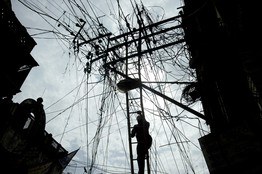Does NDPL have the power to change electricity consumption in India?

Distribution losses have historically plagued Indian power companies. In 2002, the Indian Government partnered with Tata Group in hopes of changing the industry.
The Internet of Things (IoT) allows us to collect and analyze data that we can use to develop insights and decisions. IoT projects promise to close the gap between the rich and poor by improving the distribution of the world’s resources to those who need them most.
After India’s independence in 1947, the government established State Electricity Boards (SEB) to manage the generation and distribution of electricity in India. SEBs were intended to increase necessary investments in electrical infrastructure as well as access to electricity in rural India. By the 2000s, however, Indian cities were experiencing record high electricity outages and most distribution companies were experiencing over 50% distribution losses.
During this time, Delhi’s public utility company, Delhi Vidyut Board (DVB), reported financial losses and under-billing. The key contributing factors to this were the illegal tapping of power, which accounted for approximately 20% of distribution losses, and manual billing systems. Illegal direct tapping is a behavior that has been systematized by Indian politicians. In India, politicians bribe constituents with many things in return for their vote including electronics, infrastructure improvements, and electricity access3. As a result, many Indians have come to view electricity as a right rather than a service. With approximately 25% of the country living below the poverty line, their solution has been to tap into the distribution network by attaching wires to power lines.
To combat this issue, the Delhi government disbanded DVB in 2002 and formed North Delhi Power Ltd. (NDPL), a joint venture with Tata Power Company, a subsidiary of the Tata Group. With the rise of GSM mobile technology, NDPL implemented automatic meter reading systems (AMR) which enabled the remote collection of meter readings. The traditional meter reading system was manual and time-consuming, requiring the reader to collect data in person, enter readings into the system and then generate bills. Shifting to AMR streamlined the process, increasing efficiency and reducing billing errors.
More importantly, AMR allowed NDPL to detect illegal usage real-time. Using data collected from AMR systems, the Corporate Enforcement Group (CEG) analyzed usage trends to develop predictions around expected usage. If actual usage deviated substantially from the prediction, NDPL would have zonal staff monitor the neighborhood on lookout for potential offenders. In the event of theft, officers in CEG would conduct raids with Delhi Police.
NDPL also mobilized employees and community members to prevent theft. Community members were encouraged through highly structured customer service mechanisms to call out instances of potential theft. In addition, NDPL urged the media and politicians to spread the importance of accurate readings and billing on the sustainability of NDPL. To train its employees in theft prevention tactics, NDPL taught them how meters can be manipulated (powerful magnets can deactivate the meter) and how to safeguard against this practice. To keep thieves from tapping power directly from overhead lines, employees learned to replace wires with insulated cables.
With AMR systems in place, NDPL reduced uncollected losses from 50% in early 2000 to 15% in 2009. While NDPL has utilized data to make significant advances to power distribution in India, they still have some ways to go. Billing collection has improved, but outages remain a critical issue and will only continue to grow as the population increases. I believe that NDPL needs to focus its efforts on optimizing distribution in existing networks by further studying usage patterns and incentivizing consumers to lower usage as needed. The other area where NDPL should continue to invest is in infrastructure. Because of limited infrastructure investments, electricity distribution networks are underdeveloped, limiting distribution capacity. Investing further in infrastructure will allow NDPL to deliver its customer promise of reliable and low cost electricity while also growing its customer base.
Word Count: 615
1 Evans, Dave. “The Internet of Things: How the Next Evolution of the Internet Is Changing Everything.” Cisco Internet Business Solutions Group White Paper. http://www.cisco.com/c/dam/en_us/about/ac79/docs/innov/IoT_IBSG_0411FINAL.pdf, accessed November 2016.
2 “New Delhi Electricity.” Leah Nosal. Leadership Academy for Development, Stanford University. http://www.ndpl.com/UploadedDocuments/STANFORD%20University_Delhi%20Power%20Reforms.pdf, accessed November 2016.
3 Range, Jackie. “India Has Its Own Kind of Power Struggle.” The Wall Street Journal, August 7, 2009. http://www.wsj.com/articles/SB124960029510012685.
4 Sankaran, K. “Turnaround Story in Power Distribution.” International Management Institute Working Paper. http://www.ndpl.com/UploadedDocuments/IMI%20Case%20-%20Turnaround%20Story%20in%20Power%20Distribution-%20PPP.PDF, accessed November 2016.



Interesting article! In this case, digitalization is helping the country to fight corruption. NDPL’s use of AMR is an efficient way to automate meter reading and to regulate illegal tapping of the distribution network. However, NDPL faces a different set of challenges as India develops and electricity demand continues to rise. Even though it is easy to view this as challenges, I view this as an opportunity for NDPL to incorporate modern technology as they build out their distribution network. There are a lot of existing technologies that can be utilized to build out more sophisticated infrastructure compared to developed countries that require large infrastructure update.
Really interesting! While reading this, I started to think about the other week’s climate change post, and how some of the newer advances in energy may help to mitigate the outage problem as well. While “install solar panels everywhere” would be too easy of an answer, I think there are some more practical (and likely less costly) options that could help. For example, Tesla and a few other US companies are now offering home battery units or “powerwalls” that draw power at off-peak hours (night time) and pump it back into the house during peak hours, as power companies often charge a higher rate during the peak. If a similar product could be installed in an economic manner in the areas of India that are most susceptible to black-outs, it may help reduce risk by smoothing energy consumption and also provide households/communities with limited power in the event of outages.
Here’s a link to the Tesla powerwall overview: https://www.tesla.com/powerwall